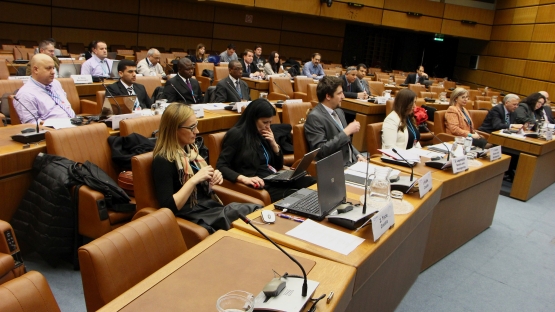Every day, throughout the world, radioactive sources are widely used for beneficial purposes in different industries, medicine, agriculture and research. However, when sources fall outside of effective control mechanisms, they can pose safety and security risks. The IAEA works in concert with its Member States and with regional partners to minimize those risks through various mechanisms, including the promotion of a 'cradle-to-grave' management of radioactive sources, a holistic approach which ensures firm control of sources from their initial fabrication to their eventual disposal.
As part of an ongoing interregional technical cooperation (TC) project1, which is working toward an improved control of radioactive sources in the Mediterranean region, 30 participants from 18 Member States attended a meeting at the IAEA's Vienna headquarters. The participating countries included Albania, Bosnia and Herzegovina, Canada, Croatia, Egypt, Ghana, Jordan, Lebanon, Libya, the Former Yugoslav Republic of Macedonia, Malta, Montenegro, Morocco, Serbia, Tunisia, Turkey, United Republic of Tanzania, and the United States of America.
Chaired by Mr Timothy Hayes of the Canadian Nuclear Safety Commission (CNSC), the meeting was convened for delegates to share their experiences in implementing the IAEA Guidance on the Import and Expert of Radioactive Sources, which provides a common framework for ensuring safety and security of the transfer of category 1 and 2 sources between the exporting State and the importing State, complementary to the guidance provided by the Code of Conduct on the Safety and Security of Radioactive Sources.
In the opening session, Mr J. Wheatley, Acting Section Head for the Regulatory Infrastructure and Transport Safety Section discussed the importance of maintaining the safety of radioactive sources during each and every import and export. Mr M. Recio, Section Head for Division for Latin America, Department of Technical Cooperation (TCLA) presented the purpose of the meeting in relation to the TC Project.
Presentations were delivered from both supplier States and importing States, allowing participants to better understand the respective roles of importers and exporters, and how there coordination is essential. The meeting participants were then divided into 'breakout' groups in order to discuss in more depth some specific aspects of the Guidance and to suggest possible improvements.
Following the breakout session, Mr Joseph Cremona, of the Occupational Health and Safety Authority of Malta, remarked, "We're learning what other countries are doing…we need regulators from other countries, so that we can discuss open topics like this."
Mr Armin Lagumdzija, a senior advisor on radiation safety at the State Regulatory Agency for Radiation and Nuclear Safety of Bosnia and Herzegovina, shared his colleague's perspective on the meeting, saying, "This meeting was a very good forum in which to share experiences, and to gain knowledge from other countries."
Through this ongoing project, and the meetings and workshops organized under it, the IAEA is supporting Member States as they strengthen their regulatory infrastructures for radiation safety and enhance their existing management systems for the recovery, conditioning, storage and disposal of radioactive sources. As the participating countries continue to develop their regulatory capacities, the benefits of the peaceful uses of nuclear technology will become more and more evident in the Mediterranean region
1 INT/9/176


